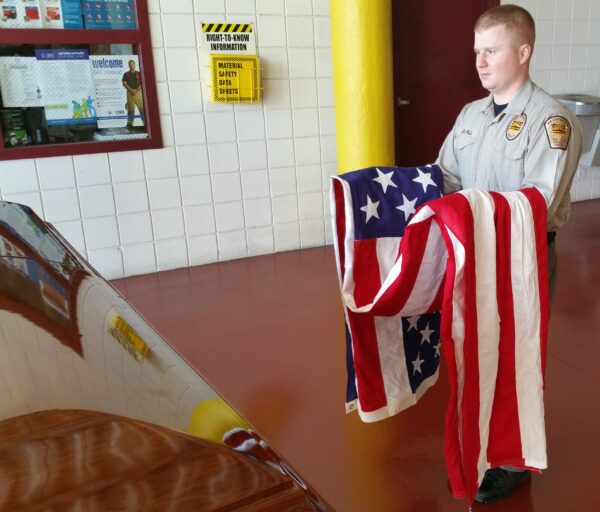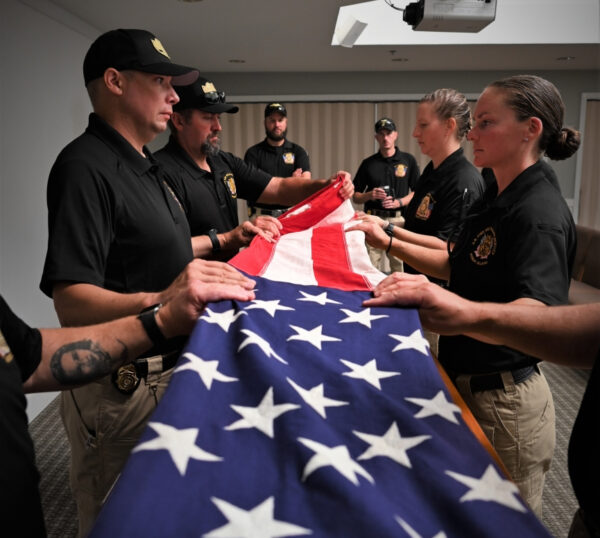There are proper ways to handle a flag. This article goes over several proper techniques and shows some that are less than desirable and even inappropriate.
For the image at the top, we do not walk/march with the flag draped over arms except for one time. Pallbearers remove the flag from a casket to place a pall on the casket in the church vestibule, a transition space between the exterior entrance and the interior of a church building. The flag is taken to an office and draped as is and not folded as the folding and unfolding would take excessive time.
At the completion of the service, the flag is retrieved, the pall removed, the flag placed, and the ceremony continues. The pallbearer who has the flag draped over his arms is out of the view of the general public.


1. Escort of the flag with armed guards.
This group is called a Flag Detail, and no one is armed. It is not a color guard. We do not treat flags as a color guard. Colors mounted on staffs form the color guard. The ones who are to be unarmed escorting the flag are halyard bearers and flag tenders depending on how large the flag is. The Detail hoists and lowers the flag at the flagpole. For details on the hoisting and lowering ceremonies, see TC 3-21.5, MCO 5060.20, or AFPAM 36-2203, all available in the Resources section of this site.

2. Traveling with an unfolded flag.
When the flag is not flying from a halyard, it is folded. The American flag is always folded when it is brought down from the halyard and transported to and from the flagpole or mast. The flag is folded into a rectangle (everyone except the military) or a triangle (only military are required to make this fold) for transport and storage.
The Polish military folds their flag in a big rectangle and marches with it with the bearer having outstretched arms, we don’t as you can see in the photo below. The Polish Airmen carry their flag their way while the USAF Airmen carry the flag, folded in a triangle, cradled in the Airman’s arms on the right.

Folded Flags

As noted above, the only the military is required to fold the flag into a triangle. Civilians can fold the flag into a rectangle. While the military requires strict adherence to the flag fold, the rectangular fold for American citizens does not have to be perfect.

When folding, the flag is brought to fully open and horizontal. This is called Popping to Tabletop/Horizontal. The only time you pop to an angle, like the demonstration photo below, is when you do not have room to bring the flag flat. Do not pop to tabletop, tilt, and then go back to tabletop as this is not authorized as part of the flag folding process. There is no such thing as “presenting the flag” like this by tilting it.

Carry Techniques
The US military uses carry techniques that are based more on tradition. Civilians and civil authorities have no obligation to use these techniques, but using one is highly encouraged since these techniques offer a secure hold.








The USAF or Army Carry technique shown above is a good default technique for anyone. There are poor techniques that either don’t look good or don’t fully support the flag.
Not the Best Hold Techniques





When Folding
Using Six handlers. Thumbs-up, like this.

Not fingers, like this.

Having two handlers. Fingers-up.



What About A Wet Flag?

This is a great question that I receive every once in a while. The flag is taken down from the halyard, folded at the pole/mast as usual (unless weather conditions are dangerous, if so, get out of there so safety), and then transported indoors where it is unfolded and draped over something that will not stain the flag while it dries. The photo at right is an example at my home.
Once morning comes, the flag is folded, marched out to the pole/mast, and hoisted as usual.

